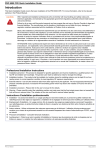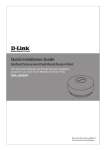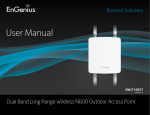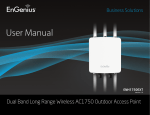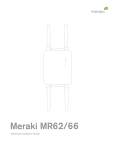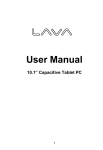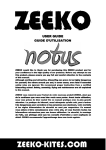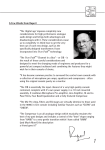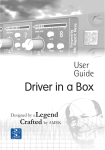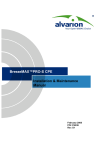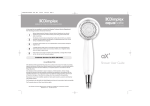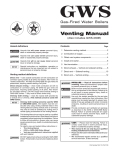Download BU/RB MIMO Quick Installation Guide
Transcript
BU/RB MIMO Quick Installation Guide This Quick Installation Guide describes the installation of the MIMO Bridge Unit/Remote Unit. This guide is intended for experienced installers. For more information refer to the relevant sections in the System Manual. CAUTION ONLY experienced installation professionals who are familiar with local building and safety codes and, wherever applicable, are licensed by the appropriate government regulatory authorities should install outdoor units and antennas. Failure to do so may void the product warranty and may expose the end user or Service Provider to legal and financial liabilities. The company and its resellers or distributors are not liable for injury, damage or regulation violations associated with the installation of Outdoor Units or antennas. français SEULS les installateurs professionnels expérimentés qui sont familiers avec les codes locaux des bâtiments et de la sécurité et, lorsque cela s'applique, qui sont autorisés par les autorités gouvernementales de régulation, doivent installer les unités extérieures et les antennes. Le non-respect de cette clause peut invalider la garantie du produit et exposer l'utilisateur final ou le prestataire de services à des responsabilités légales et financières. Le fabricant et ses revendeurs ou distributeurs ne sont pas responsables pour toute blessure, dommage ou violation de la réglementation associée à l'installation d'unités extérieures ou d'antennes. Italiano ATTENZIONE: SOLO professionisti esperti che hanno familiarità con le norme di costruzione locali e coi codici di sicurezza e, ove applicabile, sono autorizzati dalle autorità governative competenti possono installare unità esterne ed antenne. Assicurarsi che le unità esterne, antenne e strutture di supporto siano installate correttamente per eliminare ogni pericolo fisico a persone o cose. In caso contrario, ciò può invalidare la garanzia del prodotto e può esporre l'utente finale o il fornitore di servizi a responsabilità legali ed economiche. Anche quando la messa a terra non è obbligatoria in base alla normativa regolatoria applicabile e ai codici nazionali, è obbligatorio garantire che l'unità esterna e il palo dell'antenna siano messi a terra e idonei dispositivi di protezione contro i fulmini siano utilizzati in modo da fornire protezione contro le sovratensioni e le scariche statiche. In ogni caso, il Fornitore e i suoi rivenditori non sono responsabili per eventuali danni fisici, danni ad oggetti o violazioni del regolamento associati con o causati dall' installazione, la messa a terra o di protezione contro i fulmini. Package Content The BU/RB units are available in packages of single, 10, or 50 units. The following list describes the content of a package with a single unit. • • • • • One BU/RB unit (either B350, or B350D) One indoor power supply unit (IDU) Two power cables (one with a European plug and one with a USA plug) Sealing gland fastening tool One mounting kit: » » » » » » » » » One carriage One tilting bracket Two metal clamps One hook M8 threaded rods M8 hex nuts M8x20 hex screws M8 flat washers M8 spring washers Additional Equipment and Tools required for Installation • An external antenna (for B350D models only)* • Antenna cables (for B350D models only)* • Optional: service (serial) cable* • A straight outdoor Cat.5e Ethernet cable (FTP 4x2x24 AWG 100 Ohm 8P8C) with two shielded RJ-45 connectors for • • • • connecting the IDU to the ODU. This cable is available in various lengths: 20m, 30m, 50m, 70m, 90m, or a drum of 250m* (see instructions herein on preparing the cable) 4 metal bands for installing the BU/RB on 4”-6” poles* Mains plug adapter or termination plug (if the power plug on the supplied AC power cable does not fit local power outlets) A PC/Notebook for configuring the BU/RB unit Crimping tool for assembling the ethernet connectors *. Items marked with an asterisk (*) are available from the manufacturer P/N 215998 -1- March 2012 BU/RB MIMO Quick Installation Guide • • • No.13 wrench Isolation materials. Use high quality cold shrink for the antenna connectors Grounding cable with at least 18 AWG gauge and with a closed loop (lug) terminal crimped to the ground cable Equipment Location Guidelines The BU/RB unit can be installed on straight or angled poles (±45° from upward position) and on a flat surface, such as walls. Each unit package includes a tilt bracket that allows pole or wall mount installation with up/down tilt of +7.5° to -10°, and rotation of ±45°. Select the orientation and installation mode according to the Radio Planning and Site Survey recommendations. The BU/RB unit (depending on the model) is offered with either integrated antenna or external antenna. The following table details the options for each model. Follow the installation guidelines provided with the external antennas. Table 1: Antenna Configuration Options Model Integrated Antenna External Antenna BU/RB-B350-5X 23 dBi 8 deg, dual polarization N/A. BU/RB-B350D-5X N/A Note: The two antenna connectors are not operational. • • High gain dish: 28 dBi 2” parabolic dish, dual polarization Low gain antenna: 23 dBi dual polarization Note: Only two of the antenna connectors are operational. Select the optimal locations for the equipment using the following guidelines: • • • • • The outdoor unit can be either pole or wall mounted. Its location should enable easy access to the unit for installation and testing. The higher the placement of the antenna, the better the achievable link quality. ODU units with a detached antenna (D model) should be installed as close as possible to the antenna (to ensure that the antenna's characteristics are not affected by the ODU, the distance must be higher than 10 cm). The ODU with its integrated antenna (or the detached antenna) should be installed to provide a direct, or near line of sight with the antenna on the other side. The indoor equipment should be installed as close as possible to the location where the indoor-to-outdoor cable enters the building. The location of the indoor equipment should take into account its connection to a power outlet and the CPE. Outdoor Unit Installation Mount the ODU unit on a 1"-4" pole using the supplied kit: 1 Assemble the tilt bracket on the unit and fasten the M8 screws (see Figure 1). Apply torque of 80 [Lib*In] = 9 [N*m]. Holes for M8x20 screws Tilt Bracket Figure 1: Assembling the Tilt Bracket on the Unit 2 Install the carriage using one of the following methods: » For poles up to 4” - Thread the four rods through the carriage. Insert the threaded rods with the grooves pointing outward, as these grooves enable you to use a screwdriver to fasten the rods to the unit. Attach the carriage and the clamps to the P/N 215998 -2- March 2012 BU/RB MIMO Quick Installation Guide pole and tighten on both sides using the supplied washers, spring washers and nuts. Apply torque of 80 [Lib*In] = 9 [N*m]. See Figure 2. » » For poles larger than 4” - Thread the four metal bands through the grooves on the carriage and fasten. See Figure 3. For wall mount installation - Mark the exact location of the holes to drill on the wall. Drill the holes, and use four metal dowels and screws to affix the carriage to the wall. Nuts, washers and spring washers Clamps Carriage Rods Tilt fastening screws(x2) Tilt Control screw Figure 2: Assembling the Carriage on 1.5"-4" Poles Using Clamps Metal bands Tilt Control screw Figure 3: Assembling the Carriage on Poles Larger than 4" Using Metal Bands 3 4 5 6 7 Insert the Tilt Control screws into the middle-side hole of the carriage on both sides. Hang the unit with the tilt bracket on the Tilt-control screws of the carriage. Attach and fasten all the screws at both sides of the carriage. Do not over tighten. If required, slightly release the tilt bracket screws to enable rotation and the Tilt Control screws to enable tilting; adjust the unit position and tighten the screws. Apply torques of 45 [Lib*In.] = 5 [N*m] to the M6 Tilt-control screws, and 80 [Lib*In] = 9 [N*m] to the M8 screws. Cable Connection The unit is provided with sealing glands on all the cable connectors. The cables are to be connected to the unit by inserting the cable connector through the sealing gland. A dedicated tool is supplied for fastening the sealing glands. Grounding Terminal USB/RS-232 For Debug PoE In PoE Out Figure 4: Unit Connections with Sealing Glands and Gland Fastening Tool P/N 215998 -3- March 2012 BU/RB MIMO Quick Installation Guide Grounding Cable Connect one end of a grounding cable to the grounding terminal and tighten the grounding screw firmly. Connect the other end of the grounding cable to a good ground (earth) connection. Antenna Cables Note that the antenna connectors labeled ANT 5 and ANT 6 are not operational in either the model with the integrated antenna (BU/RB-B350-5X) or in the model with external antenna (BU/RB-B350D-5X). ANT 1 ANT 2 ANT 5 ANT 6 Figure 5: RF Connectors Connecting the Antenna Cables Connect one end of the coaxial RF cable (LMR 400) to the RF connector labeled ANT 1 on the unit (see Figure 5). 1 2 3 4 5 6 Slide the cold shrink sleeve onto the cable before connecting the cable. See below instructions on sealing the connectors. Connect the other end of the RF cable to the antenna. Repeat for the second RF cable (and connect to the RF connector labeled ANT 2). Seal the RF connectors to protect against rain and moisture. See below instructions. Fix the RF cable onto the pole using Velcro® wide adjustable straps. » If possible, use additional straps to route the cable such that water can accumulate on the cable bends, away from the unit. » When routing the cable, do not exceed the minimum bending radius in the cable specifications. Sealing the Antenna Cables Use high quality cold shrink sleeves to seal the connectors. 1 Cut the cold shrink sleeve to size. Take into account the size of the unit’s connector and additional 2.5 cm (1 in.). 2 Slide the cold shrink sleeve onto the cable before connecting the cable. 3 Connect the cable. 4 Attach the mastic tape (Scotchfil™ Electrical Insulation Putty) and wrap it around the connector butting up against the connector. Do not over stretch. 5 Squeeze to tighten the mastic sealer. Make sure there are no air bubbles. P/N 215998 -4- March 2012 BU/RB MIMO Quick Installation Guide 6 Slide the cold shrink sleeve on top of the connector. Make sure that the sleeve covers both cable connector and unit connector. 7 Pull the cord slowly to shrink the sleeve. Data/PoE Cable (IDU-ODU) Cable 1 2 3 4 Remove the sealing gland marked POE In from the outdoor unit. Open the gland and thread the cable through the gland’s nut. Insert the uncrimped end of the indoor-to-outdoor cable through the gland. Assemble an RJ-45 connector to the open end of the cable: Use a crimp tool for RJ-45 connectors to prepare the wires. Insert them into the appropriate pins and use the tool to crimp the connector. Make sure to do the following: » Remove as small a length as possible of the external jacket. Verify that the external jacket is well inside the sealing cover when connected to the unit, to ensure good sealing. » Pull back the shield drain wire before inserting the cable into the RJ-45 connector, to ensure a good connection with the connector's shield after crimping. The following diagram shows the required wire pair pin-to-pin connections, including the color codes used in cables supplied by the manufacturer. 5 6 7 8 Pin Wire Color 1 2 3 4 5 6 7 8 Blue Blue/white Orange Brown Brown/White Orange/white Green Green/white Connect the cable to the POE In port on the outdoor unit. Reconnect the gland. Use the dedicated tool to fasten it. Use the dedicated tool to fasten the sealing gland’s nut on the gland’s body. Connect the other end of the cable with the assembled RJ45 connector to the indoor unit’s Out port. P/N 215998 -5- March 2012 BU/RB MIMO Quick Installation Guide Indoor Unit Installation Connecting and Sealing the IDU-ODU Cable 1 Connect one end of the grounding cable to the grounding terminal on either side of the IDU and tighten the grounding screw firmly. Figure 6: IDU Grounding 2 Connect the indoor to outdoor cable to the IDU’s Out port. CAUTION 3 Do not connect the data equipment to the OUT port. The OUT port supplies DC power to the ODU, and this may harm other equipment connected to it. Connect the IN port of the indoor unit to the backhauling equipment using a standard Ethernet cable. The combined lengths of the Ethernet cables must not exceed 100m. 4 Connect the power cable to the unit's AC socket, located on the rear panel. Powering Up and Verifying Proper Operation 1 2 Connect the IDU’s AC power cable to the AC mains. The unit can operate with AC mains of 100-240 VAC, 50-60 Hz. Check the IDU LEDs. Upon power-up, all 3 LEDs will light for 2 seconds, as part of the self-test for the IDU. After these 2 seconds, the "ON" LED will illuminate green. The DC output voltage is now available for powering the ODU. The following LEDs are available on the IDU: Table 2: IDU LEDs Label Description Functionality On Power indication to the IDU Green - The IDU is powered by the AC source and DC output is available Off - ODU is not connected; ODU fault; Bad indoor-outdoor cable Fault IDU-ODU connection Red - Fault detected (see below) Off - No fault detected (after or during detection) Connect Power indication to the ODU Green - ODU is connected and powered up Off - No power to the ODU P/N 215998 -6- March 2012 BU/RB MIMO Quick Installation Guide 3 Check the ODU LEDs, indicating the unit’s status. Power Wireless Fault Signal Strength Figure 7: ODU LED Display Table 3: ODU LEDs LED Description Power Lights if power is supplied to the ODU (56 VDC). Wireless Lights at startup and if a wireless link is established. Fault Lights at startup and during operation if a fatal or critical error occurs Signal Strength Indicates wireless signal strength if a wireless link is established Table 4: Signal Strength Indicator No. of LEDs On SNR 1 LED 5 - 8 dB 2 LEDs 8 - 15 dB 3 LEDs 15 - 20 dB 4 LEDs 20 - 25 dB 5 LEDs Over 25 dB The SNR measurement is accurate only when receiving data transmissions from the associated unit. If necessary, use a continuous PING to generate data transmission. Initial Configuration Initial configuration can be performed using either the Web Management Interface or the Monitor program. 1 Connect a PC to the PoE In Ethernet port, using a crossed cable. The default IP address is 10.0.0.1 and the subnet mask is 255.255.255.0. 2 In the web browser’s address bar, type the default IP address: http://10.0.0.1. The web browser displays the login window. Type in your credentials. The following accounts are available: 3 Table 5: User Accounts 4 5 Username Default Description guest public Read-only account. Cannot change any settings. installer installer Account with writing privileges limited to commissioning settings. administratoe private Administrative account with full privileges. Click Login to access the web GUI. The Quick Settings Screen is displayed. Select either Manual settings or Configuration file options depending on the setup method. P/N 215998 -7- March 2012 BU/RB MIMO Quick Installation Guide Configuring Manual settings In many installations, most of the parameters should not be changed from their default values. However, if change is required, use the following list of the basic parameters and their default values: Table 6: Basic Parameters Parameter Description Default Select type Base Unit (BU) and Remote Base (RB). For a Point-to-Point link, one end should be set up as BU (Bridge Unit) and the other end as RB (Remote Bridge). A change in Unit Type is applied after reboot. Base Unit Country code Applies a country code. Depending on the country code, specific limitations such as maximum EIRP, available bandwidths, available channels etc. will apply to radio parameters. A change in Country Code is applied after reboot. N/A ESSID The Extended Service Set IDentifier that identifies the wireless network. Only units using the same ESSID are allowed to associate - the same ESSID must be used on both sides of a link. The ESSID can have up to 32 characters. Antenna type Indicates whether the unit is using an internal or external antenna. Depends on the type of unit. Antenna gain (dBi) • For integrated antennas, this value is automatically enforced to 23 dBi and is not configurable • For detached antennas, sets the antenna net gain. The configured gain should take into account the attenuation of the cable connecting the antenna to the unit. In units using certain Country Codes that have some limitations on allowed EIRP the configuration range for the Antenna gain parameter may be limited for compliance with these limitations. A change in Antenna gain is applied after reboot. 23 (read-only), or 0, deprnding on type of unit. Frequency (MHz) Sets a specific frequency channel to be used by the unit. Selecting Auto allows the unit to select the lowest frequency in the selected channels list. N/A Clicking on Frequency opens the Channel List window. Data encryption option • • Encryption key Applicable only if Data encryption option is set to AES. Sets the encryption key used by the AES encryption algorithm when it is enabled. A 16 characters long string. IP Address Sets the unit’s management IP address. Subnet Mask Sets the unit’s management subnet mask. Default Gateway Sets the unit’s management default gateway. Unit location Sets an optional description for the unit’s location. Disable - Wireless traffic is unencrypted. AES AES - Uses the Advanced Encryption Standard for encrypting the wireless traffic Null uploading unit settings Using the Configuration File 1 2 3 4 Select the Configuration file option button. Click Browse... A Choose file to upload window opens. Navigate to the desired configuration file, select it and click Open to upload the file and return to the Quick Settings window. Click Save. e The new configuration file will be applied after reboot. P/N 215998 -8- March 2012 BU/RB MIMO Quick Installation Guide Aligning the ODU For optimal alignment of the internal antenna, it is recommended to use the Continuous SNR Display option. Antenna alignment using the SNR bar display or the Continuous SNR Display is possible only after the RB is associated with a BU. Both units must be operational and configured with the correct basic parameters (see above). Otherwise, the two units will not be able to synchronize with each other. As the SNR measurement is performed on received frames, it is recommended to generate traffic in the wireless link (e.g. by a continuous ping). 1 2 3 4 Point the antenna of the BU (integrated into the front side of the ODU unit, or detached) towards the direction of the RB, and vice versa. Take into account the direction in both horizontal and vertical planes. See note below regarding using a compass for intial alignment. Verify that the power indication of the units is On. Verify that the Wireless LED of the ODUs is on, indicating wireless link connectivity. If the Wireless LED is off, check that the basic parameters (see Table 6) are correctly configured. Proper wireless connectivity depends also on wireless link conditions and correct orientation of the antennas. Rotate/tilt the antenna of the RB-ODU until the maximum SNR reading is achieved, where at least 1 green LED is on. If you encounter prolonged difficulty in illuminating the minimum required number of green LEDs, try to improve the reception quality by placing the antenna at a higher point or in an alternate location. All LEDs of the SNR bar display are on at SNR level of 25 dB. In many links a better link quality is expected. For links with a better quality you should always use the Continuous SNR Display option via Telnet (you may also connect a PC to the unit via the PoE Out connector). 5 6 7 Ensure that the front of the antenna is always facing the location of the BU. However, in certain conditions, such as when the line of site to the BU is hampered, better reception may be achieved using a reflected signal. In this case, the antenna is not always directed toward the BU. After achieving maximum SNR reading, secure the unit/antenna firmly to the pole. Repeat the process at the side of the BU. If applicable, verify that the achieved SNR is similar to expected SNR according to Radio Network Planning. Aligning the Antenna Using a Compass: Aligning the antenna using a compass takes into account the original azimuth and calculates a new azimuth that is shifted by ±90° from the actually required azimuth. The idea is to align the outer frame of the antenna so that it is in line with the new azimuth, which will achieve higher accuracy of initial alignment. P/N 215998 1 Point the antenna of towards the general direction of the other unit. 2 Depending on whether you are looking from the left or the right side of the antenna, add or subtract 90° to/ from the original antenna azimuth. 3 Identify a reference point on the landscape that is in the direction of the new heading. 4 Using the compass, align the outer frame of the antenna to the newly calculated azimuth, or to the reference point identified in point 3 above. -9- March 2012 BU/RB MIMO Quick Installation Guide Safety Information Professional Installation Instructions Please be advised that due to the unique function supplied by this product, the device is intended for use with our interactive entertainment software and licensed third-party only. The product will be distributed through controlled distribution channel and installed by trained professionals and will not be sold directly to the general public through retail store. 1 2 3 4 5 Installation personnel - This product is designed for specific application and must be installed by a qualified person who has RF and related rule knowledge. The general user shall not attempt to install or change the settings. Installation location - The product shall be installed at a location where the radiating antenna can be kept 20 cm from nearby person in normal operation condition to meet regulatory RF exposure requirements. External antenna - Use only the antennas which have been approved by the applicant. The non-approved antenna(s) may produce unwanted spurious or excessive RF transmitting power which may lead to the violation of FCC/IC limit and is prohibited. Installation procedure - Please refer to Chapter 3 in this manual for the details. Warning - Please carefully select the installation position and make sure that the final output power does not exceed the limit set force in relevant rules. The violation of the rule could lead to serious federal penalty. Instructions d'installation professionnelle Veuillez noter que l'appareil etant dedie a une fonction unique, il doit etre utilise avec notre logiciel proprietaire de divertissement interactif . Ce produit sera propose par un reseau de distribution controle et installe par des professionels; il ne sera pas propose au grand public par le reseau de la grande distribution. 1 2 3 4 5 Installation - Ce produit est destine a un usage specifique et doit etre installe par un personnel qualifie maitrisant les radiofrequences et les regles s'y rapportant. L'installation et les reglages ne doivent pas etre modifies par l'utilisateur final. Emplacement d'installation - En usage normal, afin de respecter les exigences reglementaires concernant l'exposition aux radiofrequences, ce produit doit etre installe de facon a respecter une distance de 20cm entre l'antenne emettrice et les personnes. Antenn externe - Utiliser uniiquement les antennes approuvees par le fabricant. L'utilisation d'autres antennes peut conduire a un niveau de rayonnement essentiel ou non essentiel depassant les niveaux limites definis par FCC/IC, ce qui est interdit. Procedure d'installation - Consulter le Chapitre 3 de ce document. Avertissement - Choisir avec soin la position d'installation et s'assurer que la puissance de sortie ne depasse pas les limites en vigueur. La violation de cette regle peut conduire a de serieuses penalites federales. Federal Communication Commission Interference Statement This device complies with Part 15 of the FCC Rules. Operation is subject to the following two conditions: (1) This device may not cause harmful interference, and (2) this device must accept any interference received, including interference that may cause undesired operation. This equipment has been tested and found to comply with the limits for a Class B digital device, pursuant to Part 15 of the FCC Rules. These limits are designed to provide reasonable protection against harmful interference in a residential installation. This equipment generates, uses and can radiate radio frequency energy and, if not installed and used in accordance with the instructions, may cause harmful interference to radio communications. However, there is no guarantee that interference will not occur in a particular installation. If this equipment does cause harmful interference to radio or television reception, which can be determined by turning the equipment off and on, the user is encouraged to try to correct the interference by one of the following measures: • • • • Reorient or relocate the receiving antenna. Increase the separation between the equipment and receiver. Connect the equipment into an outlet on a circuit different from that to which the receiver is connected. Consult the dealer or an experienced radio/TV technician for help. FCC Caution: Any changes or modifications not expressly approved by the party responsible for compliance could void the user's authority to operate this equipment. This transmitter must not be co-located or operating in conjunction with any other antenna or transmitter. For operation within 5.15 ~ 5.25GHz / 5.47 ~5.725GHz frequency range, it is restricted to indoor environment. The band from 5600-5650MHz will be disabled by the software during the manufacturing and cannot be changed by the end user. This device meets all the other requirements specified in Part 15E, Section 15.407 of the FCC Rules. Radiation Exposure Statement This equipment complies with FCC radiation exposure limits set forth for an uncontrolled environment. This equipment should be installed and operated with minimum distance 165cm between the radiator & your body. This device is intended only for OEM integrators under the following conditions: 1 2 The antenna must be installed such that 165 cm is maintained between the antenna and users, and The transmitter module may not be co-located with any other transmitter or antenna. P/N 215998 -10- March 2012 BU/RB MIMO Quick Installation Guide As long as 2 conditions above are met, further transmitter test will not be required. However, the OEM integrator is still responsible for testing their end-product for any additional compliance requirements required with this module installed. IMPORTANT NOTE: In the event that these conditions can not be met (for example certain laptop configurations or co-location with another transmitter), then the FCC authorization is no longer considered valid and the FCC ID can not be used on the final product. In these circumstances, the OEM integrator will be responsible for re-evaluating the end product (including the transmitter) and obtaining a separate FCC authorization. End Product Labeling This transmitter module is authorized only for use in device where the antenna may be installed such that 165cm may be maintained between the antenna and users. The final end product must be labeled in a visible area with the following: “Contains FCC ID: LKT-BULTRA-5”. The grantee's FCC ID can be used only when all FCC compliance requirements are met. Manual Information To the End User The OEM integrator has to be aware not to provide information to the end user regarding how to install or remove this RF module in the user's manual of the end product which integrates this module. The end user manual shall include all required regulatory information/warning as show in this manual. Europe - EU Declaration of Conformity This device complies with the essential requirements of the R&TTE Directive 1999/5/EC. The following test methods have been applied in order to prove presumption of conformity with the essential requirements of the R&TTE Directive 1999/5/EC: • EN60950-1:2006+A11:2009 Safety of Information Technology Equipment • EN50385: 2002 Generic standard to demonstrate the compliance of electronic and electrical apparatus with the basic restrictions related to human exposure to electromagnetic fields (0 Hz - 300 GHz) • EN 301 893 V1.5.1: 2008 Broadband Radio Access Networks (BRAN); 5 GHz high performance RLAN; Harmonized EN covering essential requirements of article 3.2 of the R&TTE Directive • EN 302 502 V1.2.1: 2008 Broadband Radio Access Networks (BRAN); 5,8GHz fixed broadband data transmitting systems; Harmonized EN covering essential requirements of article 3.2 of the R&TTE Directive • EN 301 489-1 V1.8.1: 2008 Electromagnetic compatibility and Radio Spectrum Matters (ERM); ElectroMagnetic Compatibility (EMC) standard for radio equipment and services; Part 1: Common technical requirements • EN 301 489-17 V2.1.1: 2009 Electromagnetic compatibility and Radio spectrum Matters (ERM); ElectroMagnetic Compatibility (EMC) standard for radio equipment and services; Part 17: Specific conditions for 2,4 GHz wideband transmission systems and 5 GHz high performance RLAN equipment This device is a 5GHz wideband transmission system (transceiver), intended for use in all EU member states and EFTA countries, except in France and Italy where restrictive use applies. In Italy the end-user should apply for a license at the national spectrum authorities in order to obtain authorization to use the device for setting up outdoor radio links and/or for supplying public access to telecommunications and/or network services. This device may not be used for setting up outdoor radio links in France and in some areas the RF output power may be limited to 10 mW EIRP in the frequency range of 2454 - 2483.5 MHz. For detailed information the end-user should contact the national spectrum authority in France. Industry Canada statement This device complies with RSS-210 of the Industry Canada Rules. Operation is subject to the following two conditions: (1) This device may not cause harmful interference, and (2) this device must accept any interference received, including interference that may cause undesired operation. Ce dispositif est conforme à la norme CNR-210 d'Industrie Canada applicable aux appareils radio exempts de licence. Son fonctionnement est sujet aux deux conditions suivantes: (1) le dispositif ne doit pas produire de brouillage préjudiciable, et (2) ce dispositif doit accepter tout brouillage reçu, y compris un brouillage susceptible de provoquer un fonctionnement indésirable. Caution: (i) the device for operation in the band 5150-5250 MHz is only for indoor use to reduce the potential for harmful interference to cochannel mobile satellite systems; (ii) the maximum antenna gain permitted for devices in the bands 5250-5350 MHz and 5470-5725 MHz shall comply with the e.i.r.p. limit; and P/N 215998 -11- March 2012 BU/RB MIMO Quick Installation Guide (iii) the maximum antenna gain permitted for devices in the band 5725-5825 MHz shall comply with the e.i.r.p. limits specified for point-to-point and non point-to-point operation as appropriate. (iv) Users should also be advised that high-power radars are allocated as primary users (i.e. priority users) of the bands 52505350 MHz and 5650-5850 MHz and that these radars could cause interference and/or damage to LE-LAN devices. Avertissement: Le guide d'utilisation des dispositifs pour réseaux locaux doit inclure des instructions précises sur les restrictions susmentionnées, notamment : (i) les dispositifs fonctionnant dans la bande 5150-5250 MHz sont réservés uniquement pour une utilisation à l'intérieur afin de réduire les risques de brouillage préjudiciable aux systèmes de satellites mobiles utilisant les mêmes canaux; (ii) le gain maximal d'antenne permis pour les dispositifs utilisant les bandes 5250-5350 MHz et 5470-5725 MHz doit se conformer à la limite de p.i.r.e.; (iii) le gain maximal d'antenne permis (pour les dispositifs utilisant la bande 5725-5825 MHz) doit se conformer à la limite de p.i.r.e. spécifiée pour l'exploitation point à point et non point à point, selon le cas. (iv) De plus, les utilisateurs devraient aussi être avisés que les utilisateurs de radars de haute puissance sont désignés utilisateurs principaux (c.-à-d., qu'ils ont la priorité) pour les bandes 5250-5350 MHz et 5650-5850 MHz et que ces radars pourraient causer du brouillage et/ou des dommages aux dispositifs LAN-EL. Radiation Exposure Statement: This equipment complies with IC radiation exposure limits set forth for an uncontrolled environment. This equipment should be installed and operated with minimum distance 165cm between the radiator & your body. Déclaration d'exposition aux radiations: Cet équipement est conforme aux limites d'exposition aux rayonnements IC établies pour un environnement non contrôlé. Cet équipement doit être installé et utilisé avec un minimum de 165cm de distance entre la source de rayonnement et votre corps. Disposal of Electronic and Electrical Waste Disposal of Electronic and Electrical Waste Pursuant to the WEEE EU Directive electronic and electrical waste must not be disposed of with unsorted waste. Please contact your local recycling authority for disposal of this product. P/N 215998 -12- March 2012












